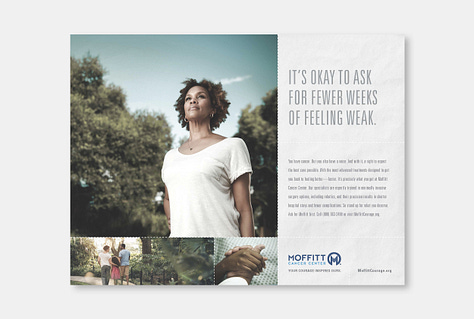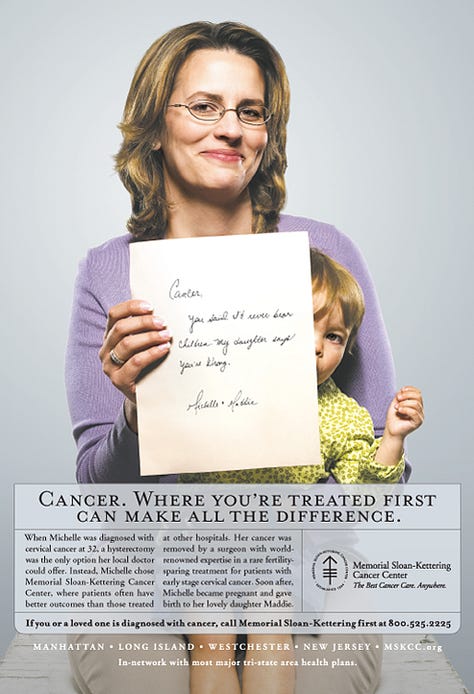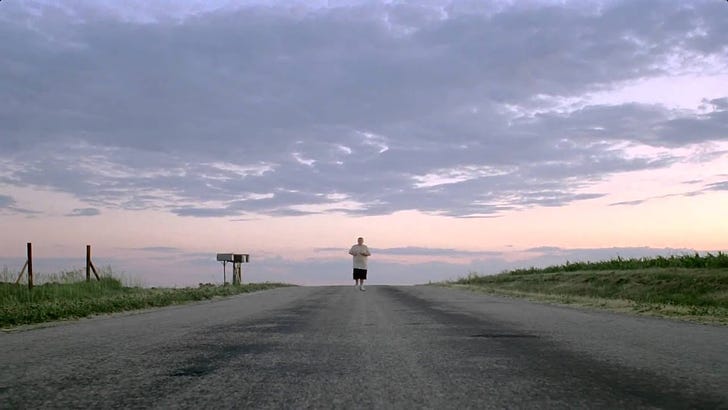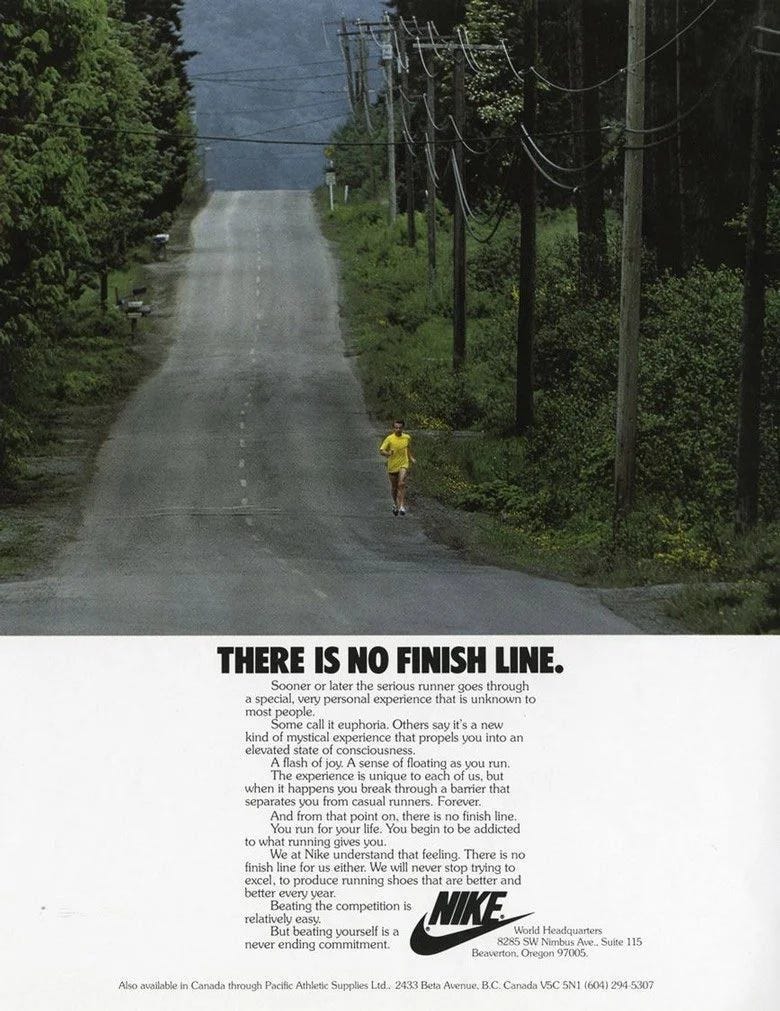“Sooner or later the serious runner goes through a special, very personal experience that is unknown to most people.”
Hello! Thank you to everyone who read Mo’s post last week. Her story resonated with so many of you. This week I’m covering a couple of posts that I saw recently on LinkedIn. I felt strongly about both and I’m interested to see if you agree.
I also want to say how much I appreciate everyone who subscribes or follows Cancer Culture. Please click the button below to share with someone you know. There is always more room at this table.
Recently, a Nike historian (who knew?) on LinkedIn told the story behind a classic 1977 Nike advertisement. Apparently, the full-page spread was the brainchild of John Brown, the legendary ad exec who worked with Phil Knight to introduce Nike’s shoes to the running world.
In the early years of Nike, their magazine ads focused exclusively on the technology that Nike’s shoes offered and were primarily directed toward runners. One month there was no new model to release so the Nike marketing manager directed the agency to “write an ad that makes runners feel good about themselves.” Here’s what happened:
“Photographer Bob Peterson found a location in Redmond, Washington where he captured a man enjoying a morning run along an urban road. The man was Howard Miller, a friend of Peterson's, who ran to work every day at the University of Washington. In the photograph there is no discernible Nike Swoosh...the runner is so far away you can barely see him. Bob told me the goal was to "focus on the environment and not the runner.’"
Peterson brought the photo in, and the agency wrote the text. The Nike executives were not exactly thrilled about the ad but agreed to run it. And a funny thing happened.
Hundreds of runners wrote thank you notes to Nike and clamored to buy the poster-sized versions hanging in stores. Eventually, Nike re-printed the posters to sell.
This ad was Nike’s first to focus on the customer rather than the product. “There is no finish line” launched Nike’s advertising approach for the decades that followed. Some equate the impact of this phrase to the iconic “Just do it” that followed.
My first reaction when I saw the ad was “Now, THAT is what life after cancer looks like.”
Even as patients "ring the bell" to celebrate a last treatment or final infusion, they realize the race continues. As their most beloved supporters cheer "returning to normal," patients understand that there are new hills to face and what outsiders see as the finish line is really just the beginning.
The difference in this race is that the crowds are gone. The dramatic battle has been fought and the process of recovery is just not as sexy. Often, the healthcare system is no longer *with you*. The treatment team has gone back to follow the next group out of the starting blocks. A realization slowly dawns that, like the figure in the Nike ad, patients are on their own to figure out this next phase.
I wouldn’t blame patients for wondering if this is a case of false advertising. Scrolling through cancer center advertisements, most include a strong message to choose the “right” place. Larger centers emphasize their expertise while smaller hospitals promise cancer care closer to home. All imply that they will provide comprehensive cancer care focused on *you.*



But I have yet to see an advertisement promising to be the right place AFTER treatment is over. Unfortunately, this also reflects many patient’s experiences. Most cancer centers do not provide comprehensive survivorship care. Other than basic surveillance visits, the road after cancer (or with chronic cancer) can be long, lonely and challenging.
How do I know this? I’m so glad you asked. I’ll give you the most recent example.
This month’s issue of the Journal of Cancer Survivorship contained this article:
The authors collected data from patients who are members of the online Cancer Support Community, a great organization that is an excellent, free resource for patients with cancer. I’ve used their survivorship programs at a couple of rural hospitals that did not have the staff or budget to provide their own.
The population studied included over 400 hundred participants with a variety of metastatic (Stage IV cancers). The majority were breast and colorectal survivors. Patients self-reported the experience in five domains of concerns (emotional well-being, symptom burden, body image/healthy lifestyle, healthcare team communication, and relationships/intimacy).
Not surprisingly, the study reports:
Nearly all (96%) reported at least one survivorship concern, with the most prevalent concern about cancer progression or recurrence.
And the conclusions and implications were as follows:
Conclusion
Individuals with metastatic cancer experience a variety of moderate-to-severe survivorship concerns that warrant additional investigation.
Implications for cancer survivors
As the population of individuals with metastatic cancer lives longer, future research must investigate solutions to address modifiable factors associated with survivorship concerns, such as unemployment due to disability.
This report falls on top of decades of these types of reports detailing the concerns of cancer survivors. This is not earth-shattering news.
What frustrates me is that after twenty plus years of research, we know that cancer survivors have concerns and we know where to start to help: rehabilitation, medications, therapy, art, yoga, diet, financial support, monitoring for late effects, encouragement, community, connection, and many others.
Heck, there are even guidelines for survivorship care.
So why do so many patients still feel like they are running this part of the race alone? Because they are. Even in centers of excellence, survivorship care FOR EVERYONE is not a priority.
I’ll give you just a few examples of how I know this is the case:
A recent review of Commission on Cancer certified cancer centers reported that less than half described a survivorship program on their websites.
In a 2020 survey of NCI designated comprehensive cancer centers, less than half reported meeting the survivorship needs of patients with leukemia.
I could go on.
Survivorship is a missed opportunity for cancer centers - to serve the patients their ads desperately entice to walk in the front door. And no patient should have to run those hills alone.
What do you think? Am I on the right track?
***If you are a survivor looking for connection, please leave your contact information below for others. As one of my favorite Substack lawyers,
, says “We are in this together.”






As a patient advocate obsessed with long term survivorship issues I really appreciate all the info in this! And yes, survivorship issues should be considered a second level of standard care once the initial critical treatment phase ends. And I think every person diagnosed should receive at least 6-10 therapy sessions. No matter how anyone acts, we are all broken in some way by cancer.
I am a stage 3 rectal cancer survivor and I am so happy to see you discussing this. I was a healthy, fit 42 year old mother of 3, and cancer transformed my life completely. My newsletter, New Found Life,
Is all about the period of time after cancer. The changes I had to accept and navigate after cancer, including early onset menopause, a permanent colostomy and severe anxiety/PTSD symptoms left me questioning why everyone else seemed to think I was “finished” with my cancer experience!! The aftermath is real, and survivors need so much more support than they are given in most cases.